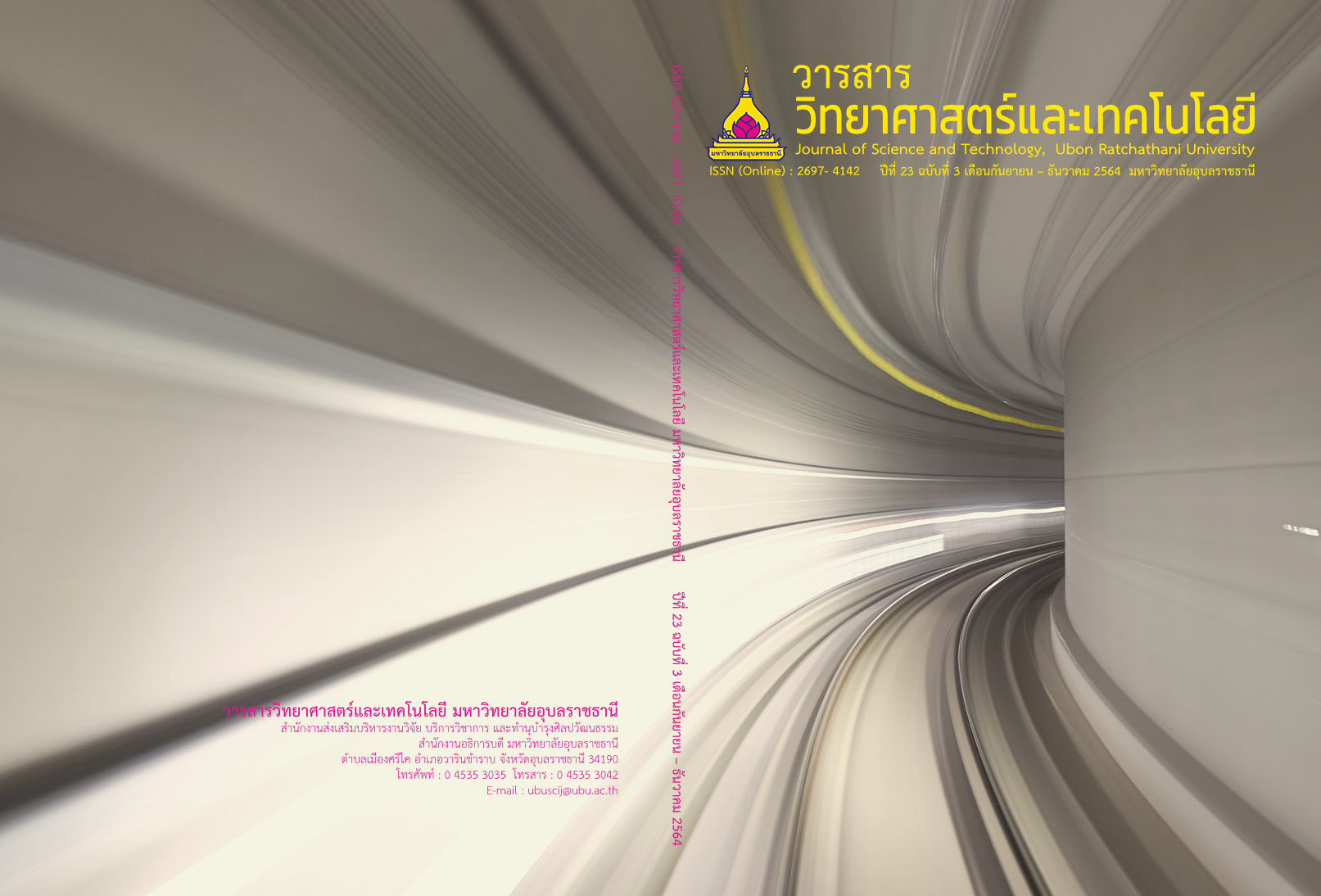การพัฒนาเทคโนโลยีการผลิตเห็ดนางรมเทาด้วยวัสดุเพาะฟางข้าวเสริมซีลีเนียม
Main Article Content
บทคัดย่อ
การพัฒนาเทคโนโลยีการผลิตเห็ดเพื่อเพิ่มการสะสมซีลีเนียมในเห็ดด้วยวิธีการเสริมปุ๋ยอินทรีย์ซีลีเนียมลงไปในฟางข้าวทั่วไปที่ปลูกด้วยวิธีปกติ และฟางข้าวที่มีปริมาณซีลีเนียมสูงที่ได้จากการผลิตข้าวเสริมซีลีเนียม นำฟางข้าวเสริมซีลีเนียมมาเพาะเห็ดนางรมเทา (Pleurotus ostreatus: grey type) สายพันธุ์ TISTR_Post grey-01 และหาความเข้มข้นของซีลีเนียมที่เหมาะสมต่อการเจริญเติบโตของเส้นใย ปริมาณผลผลิต คุณภาพของเห็ด และปริมาณซีลีเนียมทั้งหมดในดอกเห็ดนางรมเทา จากผลการทดลอง พบว่าวัสดุเพาะฟางข้าวทั่วไปและฟางข้าวซีลีเนียมสูงให้ผลในแนวทางเดียวกัน สูตรวัสดุเพาะที่ไม่มีการเสริมซีลีเนียมมีการเจริญของเส้นใยต่ำกว่าสูตรที่เสริมซีลีเนียม การเสริมซีลีเนียมในวัสดุเพาะที่ความเข้มข้นเท่ากับ 3 และ 5 มิลลิกรัมต่อกิโลกรัม (ppm) เป็นอัตราส่วนที่เหมาะสมที่สุดต่อการเจริญของเส้นใย คุณภาพ และผลผลิตเห็ดนางรมเทา อย่างไรก็ตามการเสริมซีลีเนียมในวัสดุเพาะที่ความเข้มข้นสูงกว่า 10 มิลลิกรัมต่อกิโลกรัม ส่งผลให้การเจริญของเส้นใยและคุณภาพดอกเห็ดลดลงตามความเข้มข้นของซีลีเนียมที่เพิ่มขึ้น นอกจากนี้ปริมาณซีลีเนียมสะสมในดอกเห็ดมีแนวโน้มเพิ่มขึ้นตามปริมาณซีลีเนียมที่เสริมลงในฟางข้าวทั่วไปและฟางข้าวซีลีเนียมสูง โดยมีค่าเฉลี่ยในช่วง 140-930 ไมโครกรัมต่อกิโลกรัมน้ำหนักแห้ง และ 220-340 ไมโครกรัมต่อกิโลกรัมน้ำหนักแห้ง ตามลำดับ การศึกษานี้แสดงให้เห็นว่าเทคโนโลยีการผลิตเห็ดที่นำเสนอนี้สามารถเพิ่มผลผลิต คุณภาพ และคุณค่าทางโภชนาการของเห็ดนางรมเทา
Article Details
บทความที่ได้รับการตีพิมพ์เป็นลิขสิทธิ์ของ วารสารวิทยาศาสตร์และเทคโนโลยี มหาวิทยาลัยอุบลราชธานี
ข้อความที่ปรากฏในบทความแต่ละเรื่องในวารสารวิชาการเล่มนี้เป็นความคิดเห็นส่วนตัวของผู้เขียนแต่ละท่านไม่เกี่ยวข้องกับมหาวิทยาลัยอุบลราชธานี และคณาจารย์ท่านอื่นๆในมหาวิทยาลัยฯ แต่อย่างใด ความรับผิดชอบองค์ประกอบทั้งหมดของบทความแต่ละเรื่องเป็นของผู้เขียนแต่ละท่าน หากมีความผิดพลาดใดๆ ผู้เขียนแต่ละท่านจะรับผิดชอบบทความของตนเองแต่ผู้เดียว
เอกสารอ้างอิง
Mkhize, S.S. and et al. 2016. Performance of Pleurotus ostreatus mushroom grown on maize stalk residues supplemented with various levels of maize flour and wheat bran. Food Science and Technology. 36(4): 598-605.
Wongpaosakul, C. 2012. Pleurotus sp. Mushroom Selection with Mono-Mono Crossing. B.Sc. Thesis, Rajamangala University of Technology Thanyaburi. (in Thai)
Fongngern, W., Pechhan, S. and Yajoh, R. 2012. Application with the internet of things technology control in smart farms mushroom. Journal of Information Technology Management and Innovation. 5(1): 172-182. (in Thai)
Chinwang, S. and et al. 2013. Lower production cost of oyster mushroom (Pleurotus ostreatus) by using agricultural wastes and weed plants as culturing substrates. Rajabhat Agriculture Journal. 12(1): 12-19. (in Thai)
Keophila, M. and et al. 2013. Effect of rice straw on rice yields, pH, electrical conductivity and bulk density of paddy soil. KKU Research Journal (Graduate Studies). 13(2): 1-9. (in Thai)
Gou, G. and et al. 2017. Environmentally friendly method for the separation of cellulose from steam-exploded rice straw and its high-value applications. In: Kazi, S.N. (ed.) Pulp and Paper Processing. London: IntechOpen.
Sarnklong, C. and et al. 2010. Utilization of rice straw and different treatments to improve its feed value for ruminants: A review. Asian Australasian Journal of Animal Sciences. 23(5): 680-692.
Shen, J. and et al. 2019. Selenium distribution and translocation in rice (Oryza sativa L.) under different naturally seleniferous soils. Sustainability. 520: 1-11.
Terry, E.N. and Diamond, A.M. 2012. Selenium. In: Erdman, J.W., Macdonald, L.A. and Zeisel, S.H. (eds.) Present Knowledge in Nutrition, 10th edition. Washington, D.C.: John Wiley & Sons.
Silva, M.C.S. and et al. 2012. Enrichment of Pleurotus ostreatus mushrooms with selenium in coffee husks. Food Chemistry. 131: 558-563.
Kieliszek, M. and Błazejak, S. 2016. Current knowledge on the importance of selenium in food for living organisms: A review. Molecules. 21(609): 1-16. ˙
Bureau of Nutrition, Department of Health, Ministry of Public Health. 2020. Dietary Reference Intake for Thais 2020. https://www.thaidietetics.org/wp-content/uploa ds/2020/04/dri2563.pdf. Accessed 1 September 2021. (in Thai)
Milovanovic, L. and et al. 2014. Potential of Pleurotus ostreatus mycelium for selenium absorption. The Scientific World Journal. 681-834.
Silva, M.C.S. and et al. 2019. Growth and tolerance of Pleurotus ostreatus at different selenium forms. Journal of Agricultural Science. 11(2): 151-158.
Zou, Y. and et al. 2018. Selenium speciation and biological characteristics of selenium-rich Bailing mushroom, Pleurotus tuoliensis. Emirates Journal of Food and Agriculture. 30(8): 704-708.
Kaur, G., Kalia, A. and Sodhi, H. 2018. Selenium biofortification of Pleurotus species and its effect on yield, phytochemical profiles, and protein chemistry of fruiting bodies. Journal of Food Biochemistry. 42(2): e12467.
Oliveira, A.P.D. and Naozuka, J. 2019. Preliminary results on the feasibility of producing seleniumenriched pink (Pleurotus djamor) and white (Pleurotus ostreatus) oyster mushrooms: Bioaccumulation, bioaccessibility, and Se-proteins distribution. Microchemical Journal. 145: 1143-1150.
Kong, W.S. 2004. Description of commercially important Pleurotus species. In: Choi, K.W. (ed.) Mushroom Growers’ Handbook 1: Oyster Mushroom Cultivation. Seoul: MushWorld.
Silva, M.C.S. and et al. 2012. Enrichment of Pleurotus ostreatus mushrooms with selenium in coffee husks. Food Chemistry. 131(2): 558-563.
Bhatia, P., Prakash, R. and Prakash, N.T. 2013. Selenium uptake by edible oyster mushrooms (Pleurotus sp.) from selenium-hyperaccumulated wheat straw. Journal of Nutritional Science and Vitaminology. 59(1): 69-72.
Nunes, R.G. and et al. 2012. Selenium bioaccumulation in shiitake mushrooms: A nutritional alternative source of this element. Journal of Food Science. 77(9): 983-986.
Ogra, Y. and et al. 2004. Speciation of selenium in selenium-enriched shiitake mushroom, Lentinula edodes. Analytical and Bioanalytical Chemistry. 379: 861–866.
Wu, Y. and et al. 2012. The analysis of selenoprotein and Se-polysaccharide in selenium-enriched Lentinan edodes. Advanced Materials Research. 524-527: 2325-2329.
Kabata-Pendias, A. 2011. Trace Elements in Soils and Plants, 4th edition. Boca Raton: CRC Press. 1-20.
Zhao, C. and et al. 2005. Study on the relationship between soil selenium and plant selenium uptake. Plant Soil. 277: 197-206.
Fordyce, F.M. 2013. Selenium deficiency and toxicity in the environment. In: Selinus, O. (ed.) Essentials of Medical Geology. Dordrecht: Springer.
Li, Z. and et al. 2017. Interaction between selenium and soil organic matter and its impact on soil selenium bioavailability: A review. Geoderma. 295: 69-79.
Ho, L.H., Zulkifli, N.A. and Tan, T.C. 2020. Edible mushroom: Nutritional properties, potential nutraceutical values, and its utilisation in food product development. In: Passari, A. and Sanchez, S. (eds.) An Introduction to Mushroom. London: IntechOpen.
Oei, P. 1991. Manual on Mushroom Cultivation: Techniques, Species and Opportunities for Commercial Application in Developing Countries. Amsterdam: TOOL Publications.


